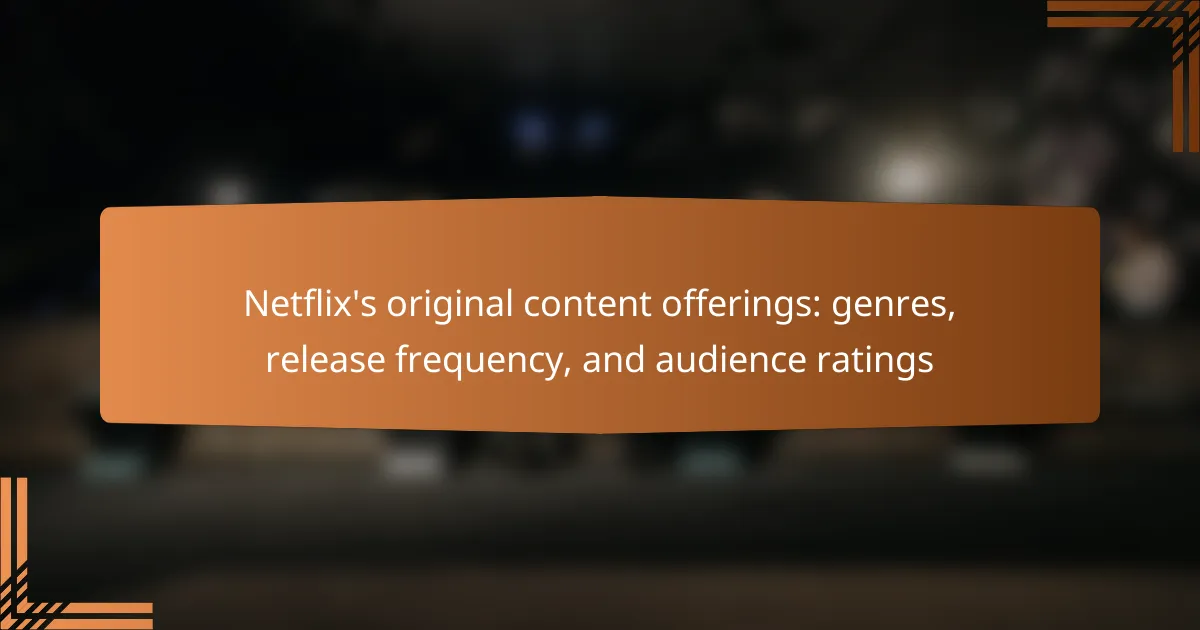Netflix is a leading streaming platform known for its diverse range of original content, which includes various genres such as drama, comedy, thriller, horror, and documentaries. The platform produces original series like “Stranger Things,” “The Crown,” and “Bridgerton,” as well as films including “Roma” and “The Irishman.” Netflix regularly updates its library with new titles, releasing original content weekly, and its offerings have garnered critical acclaim and numerous awards. Audience ratings for Netflix’s original content are influenced by factors such as genre, storytelling quality, star power, viewer demographics, and marketing strategies. Additionally, Netflix’s content strategy has reshaped consumption patterns in the entertainment industry, emphasizing binge-watching and significant investment in diverse programming to attract a broad audience.

What are Netflix’s original content offerings?
Netflix’s original content offerings include a wide range of genres. These genres encompass drama, comedy, thriller, horror, and documentaries. Netflix produces original series, films, and stand-up specials. Notable original series include “Stranger Things,” “The Crown,” and “Bridgerton.” The platform also releases original films like “Roma” and “The Irishman.” Netflix frequently updates its library with new content. It releases new original titles on a weekly basis. Audience ratings for these offerings vary, with many achieving critical acclaim. Netflix’s original content has won numerous awards, including multiple Emmys and Oscars.
How does Netflix define original content?
Netflix defines original content as programming produced, commissioned, or acquired exclusively for its platform. This includes movies, series, documentaries, and specials. Original content is distinct from licensed content, which is obtained from other creators. Netflix invests heavily in original content to attract and retain subscribers. As of 2023, Netflix has produced thousands of hours of original programming. This strategy helps differentiate Netflix from competitors. Original content often receives critical acclaim and awards, further enhancing its brand.
What types of content are classified as original?
Original content includes films, series, documentaries, and specials produced by Netflix. This content is unique to the platform and not available elsewhere. Netflix invests significantly in original programming. According to a 2021 report, Netflix spent over $17 billion on original content. Original series often feature exclusive storytelling and talent. Examples include “Stranger Things,” “The Crown,” and “The Queen’s Gambit.” These titles are developed in-house or through partnerships with creators. Original content aims to attract and retain subscribers.
How does Netflix differentiate between original and licensed content?
Netflix differentiates between original and licensed content by ownership and production. Original content is produced or commissioned by Netflix, giving it full control over distribution and rights. Examples include series like “Stranger Things” and films like “The Irishman.” Licensed content, on the other hand, is acquired from third-party producers. This content includes shows and movies like “The Office” and “Breaking Bad.” Netflix pays for the rights to stream these titles for a specific period. The distinction is crucial for content strategy, as original offerings drive subscriptions and brand identity.
What genres are represented in Netflix’s original content?
Netflix’s original content represents a wide variety of genres. These include drama, comedy, thriller, documentary, horror, and science fiction. Additionally, Netflix features genres like romance, animation, and family programming. The platform continually expands its offerings to include niche genres such as fantasy and international films. In 2021, Netflix reported over 1,500 original titles across these genres. This diverse range caters to a broad audience, ensuring that there is something for everyone.
What are the most popular genres of Netflix original content?
The most popular genres of Netflix original content include drama, comedy, thriller, and documentary. Drama series often attract large audiences due to their compelling storytelling. Comedy shows provide entertainment and relief, appealing to a broad demographic. Thrillers engage viewers with suspenseful plots and unexpected twists. Documentaries offer in-depth exploration of real-world topics, garnering interest from knowledge-seeking audiences. In 2021, Netflix reported that drama was the leading genre, followed closely by comedy and thriller, based on viewership statistics.
How does Netflix cater to niche genres?
Netflix caters to niche genres by offering a diverse range of original content tailored to specific audience interests. The platform invests in unique storytelling and unconventional themes. This strategy attracts various viewer segments who seek content beyond mainstream offerings. For instance, Netflix has produced successful series like “The Haunting of Hill House” for horror enthusiasts and “BoJack Horseman” for animated [censured] comedy fans. The platform utilizes data analytics to identify viewer preferences and emerging trends. This data-driven approach informs content creation and acquisition strategies. As a result, Netflix has expanded its library with titles that appeal to underserved audiences. This commitment to niche genres enhances subscriber retention and engagement.
How frequently does Netflix release original content?
Netflix releases original content on a regular basis, typically adding new titles every week. In 2021, Netflix released over 70 original films and series per month. This frequency has become a key part of its strategy to attract and retain subscribers. The platform aims to offer diverse genres and formats, including films, documentaries, and series. As of 2023, Netflix continues to follow this pattern, often premiering multiple new titles each week. This consistent release schedule helps maintain viewer engagement and satisfaction.
What is the typical release schedule for original series and films?
Netflix typically releases original series and films on a weekly or monthly basis. Series often drop all episodes at once, promoting binge-watching. New films may premiere monthly, with specific release dates announced in advance. For example, Netflix’s release calendar shows a mix of genres and formats. This strategy maintains viewer engagement and attracts subscribers. Regular updates on upcoming releases are available on Netflix’s official platform.
How does release frequency impact audience engagement?
Release frequency significantly impacts audience engagement. Higher release frequency keeps audiences consistently engaged with new content. This leads to increased viewer retention and loyalty. For instance, a study by Nielsen found that binge-watching increases viewer engagement, with 70% of viewers preferring to watch multiple episodes in one sitting. Additionally, platforms like Netflix benefit from frequent releases, as they encourage viewers to return regularly. This strategy can lead to higher ratings and increased social media buzz. Consistent content availability fosters community discussions and viewer anticipation, further enhancing engagement levels.

What factors influence audience ratings for Netflix’s original content?
Audience ratings for Netflix’s original content are influenced by several factors. Key factors include genre, storytelling quality, and star power. Genre affects audience expectations and preferences. High-quality storytelling often leads to better engagement and ratings. Star power can attract viewers and enhance credibility. Viewer demographics also play a significant role in ratings. Additionally, marketing strategies and social media buzz impact audience perceptions. Release timing and competition from other platforms can also influence ratings. Reviews and ratings from critics contribute to audience decisions. Overall, a combination of these factors shapes how audiences rate Netflix’s original content.
How are audience ratings measured for Netflix originals?
Audience ratings for Netflix originals are measured through viewership data and engagement metrics. Netflix tracks the number of views for each title. It also analyzes completion rates, which indicate how many viewers finish a series or film. Additionally, Netflix considers user ratings and feedback from its platform. The company uses this data to assess the popularity and performance of its originals. This measurement approach helps Netflix understand audience preferences and trends. By analyzing this information, Netflix can make informed decisions about future content.
What metrics are used to assess viewer satisfaction?
Metrics used to assess viewer satisfaction include Net Promoter Score (NPS), Customer Satisfaction Score (CSAT), and viewer retention rates. NPS measures the likelihood of viewers recommending content to others. CSAT gauges immediate satisfaction after watching a show or movie. Viewer retention rates indicate how many viewers continue to watch Netflix content over time. These metrics provide insights into audience engagement and preferences. For instance, a high NPS suggests strong viewer loyalty, while low retention rates may indicate dissatisfaction with content offerings.
How do audience ratings compare across different genres?
Audience ratings vary significantly across different genres on Netflix. For instance, dramas often receive higher ratings compared to comedies. According to a study by Statista, drama series had an average audience rating of 8.1 out of 10, while comedies averaged 7.3. Documentaries also perform well, with ratings around 7.8. In contrast, horror genres tend to receive lower ratings, averaging 6.5. These ratings reflect viewer preferences and engagement levels within each genre.
What role does critic feedback play in audience ratings?
Critic feedback significantly influences audience ratings. Critics provide professional assessments that can shape public perception. Positive reviews can enhance audience interest and boost ratings. Conversely, negative critiques may deter viewers and lower ratings. Research shows that films with high critic scores often correlate with higher audience ratings. For example, a study by the University of Southern California found that critic scores on Rotten Tomatoes directly impact audience scores. This relationship highlights the importance of critic feedback in shaping audience opinions.
How do critics’ reviews affect viewer perceptions?
Critics’ reviews significantly shape viewer perceptions of content. Positive reviews often lead to increased interest and viewership. Conversely, negative reviews can deter potential viewers from engaging with a show or movie. Research indicates that 70% of viewers rely on critic ratings when deciding what to watch. For example, films with high critic scores on platforms like Rotten Tomatoes tend to attract larger audiences. This influence extends to Netflix’s original content, where critics’ opinions can impact overall ratings and popularity. Viewer decisions are often swayed by the credibility and reputation of critics, reinforcing the importance of reviews in shaping audience perceptions.
What is the relationship between critic ratings and audience ratings?
Critic ratings and audience ratings often reflect different perspectives on content. Critics typically evaluate based on artistic merit, technical execution, and narrative depth. Audience ratings, on the other hand, are influenced by personal enjoyment and relatability.
Research has shown that there can be a significant disparity between the two. For example, a study by the University of Southern California found that audience scores on platforms like Rotten Tomatoes frequently diverge from critic scores, often favoring more mainstream or entertaining content.
In some cases, high critic ratings do not correlate with high audience ratings, indicating a disconnect in expectations. Conversely, some films or shows may receive low critic scores but achieve high audience approval, suggesting that popularity does not always align with critical acclaim.
This relationship indicates that while both ratings provide valuable insights, they serve different purposes and audiences.

What are the implications of Netflix’s original content strategy?
Netflix’s original content strategy has significant implications for the entertainment industry. It reshapes viewer consumption patterns by prioritizing binge-watching through complete season releases. This strategy enhances subscriber retention, as viewers are more likely to stay engaged with a library of original shows. Netflix’s investment in diverse genres broadens audience appeal, attracting various demographics. The strategy also influences production trends, encouraging other networks to develop original programming. In 2021, Netflix allocated over $17 billion to content creation, highlighting its commitment to original offerings. This substantial investment has led to critical acclaim and award recognition, further establishing Netflix as a leader in the streaming market.
How does original content impact Netflix’s market position?
Original content significantly enhances Netflix’s market position. It distinguishes the platform from competitors. Unique shows and movies attract and retain subscribers. For instance, Netflix’s original series, like “Stranger Things,” have garnered millions of viewers. This popularity leads to increased subscription growth. In 2020, Netflix reported 37% of new sign-ups were driven by original content. Additionally, original content fosters brand loyalty among users. Subscribers are more likely to stay due to exclusive offerings. Overall, original content is a pivotal factor in Netflix’s competitive advantage.
What competitive advantages does original content provide?
Original content provides a significant competitive advantage by differentiating a brand from its competitors. It fosters brand loyalty by offering unique stories and experiences that cannot be found elsewhere. This exclusivity attracts subscribers who seek fresh and diverse programming. According to a 2021 survey, 70% of viewers prefer platforms with original content. Additionally, original content enhances viewer engagement and retention, leading to longer subscription durations. Netflix’s investment in original series and films has led to increased market share, solidifying its position as a leader in the streaming industry.
How does original content influence subscriber growth?
Original content significantly influences subscriber growth by attracting new viewers and retaining existing ones. Unique programming differentiates a platform, making it more appealing. For example, Netflix’s original series like “Stranger Things” and “The Crown” have driven millions of new subscriptions. According to a 2021 report by Ampere Analysis, original content accounted for 50% of Netflix’s subscriber growth. This data shows that exclusive shows create buzz and increase word-of-mouth marketing. Additionally, original content fosters viewer loyalty, as subscribers feel invested in ongoing series. Overall, original content is crucial for sustained subscriber expansion.
What trends are emerging in Netflix’s original content offerings?
Netflix is increasingly focusing on diverse genres and formats in its original content. This includes a rise in animated series and films, appealing to both children and adults. Additionally, there is a growing emphasis on international productions, reflecting global audience preferences. Netflix is also investing in limited series and docuseries, which often attract higher viewer engagement. The platform has seen success with interactive storytelling, allowing viewers to choose plot directions. Data indicates that Netflix has released over 1,500 original titles in 2021 alone, showcasing its commitment to expanding content offerings. Overall, these trends demonstrate Netflix’s strategy to cater to varied audience interests and maximize viewer retention.
How is audience demand shaping future content strategies?
Audience demand is significantly shaping future content strategies. Streaming platforms like Netflix analyze viewer preferences and engagement metrics. This data informs decisions on genre selection and content types. For instance, Netflix invests heavily in popular genres like drama and documentary based on audience ratings. The frequency of releases is also adjusted to meet demand, ensuring a steady flow of new content. According to a report by Deloitte, 70% of viewers prefer platforms that offer frequent new releases. This trend influences Netflix to prioritize original productions that align with audience interests. By continuously adapting to viewer feedback, Netflix enhances user satisfaction and retention.
What innovations are being explored in original content production?
Innovations in original content production include interactive storytelling and AI-generated scripts. Interactive storytelling allows viewers to influence plot outcomes, enhancing engagement. Netflix’s “Black Mirror: Bandersnatch” exemplifies this approach, offering multiple endings based on viewer choices. AI-generated scripts utilize algorithms to analyze successful narratives and create new content. Research indicates that AI can streamline the writing process and improve content personalization. Additionally, virtual reality (VR) and augmented reality (AR) are being explored for immersive experiences. These innovations aim to enhance viewer engagement and satisfaction in original content production.
What tips can viewers use to find the best Netflix original content?
To find the best Netflix original content, viewers should explore user ratings and reviews. Checking platforms like Rotten Tomatoes can provide insight into critical reception. Browsing Netflix’s “Top 10” list showcases popular titles currently trending. Utilizing personalized recommendations based on viewing history can also help discover new favorites. Engaging with social media discussions about Netflix shows can reveal hidden gems. Following entertainment news for upcoming releases keeps viewers informed about anticipated titles. Lastly, exploring different genres can broaden viewing options and uncover unique content.
Netflix’s original content offerings encompass a diverse range of genres, including drama, comedy, thriller, horror, and documentaries, with notable titles such as “Stranger Things,” “The Crown,” and “Bridgerton.” The platform defines original content as programming produced or commissioned exclusively for Netflix, differentiating it from licensed content. Regular releases of original films and series, often on a weekly basis, contribute to audience engagement and retention, while audience ratings are influenced by factors such as genre, storytelling quality, and critic feedback. The article will explore the implications of Netflix’s content strategy on its market position, subscriber growth, and emerging trends in original programming.
